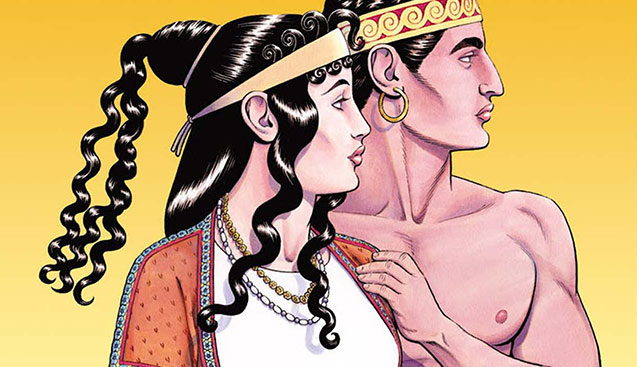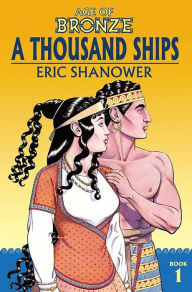A Story That’s Lasted for Millenia: Eric Shanower on the New Edition of Age of Bronze
 Eric Shanower’s long-running chronicle of the Trojan War, Age of Bronze, has now well outlasted the war itself. For the 20th anniversary of the series’ beginning, the first volume, A Thousand Ships, has been given a new trade paperback edition and a new coat of paint—for the first time, the graphic novel is presented in full color thanks to artist John Dallaire and Image Comics. Other volumes will follow.
Eric Shanower’s long-running chronicle of the Trojan War, Age of Bronze, has now well outlasted the war itself. For the 20th anniversary of the series’ beginning, the first volume, A Thousand Ships, has been given a new trade paperback edition and a new coat of paint—for the first time, the graphic novel is presented in full color thanks to artist John Dallaire and Image Comics. Other volumes will follow.
Age of Bronze Volume 1: A Thousand Ships (New Edition)
Age of Bronze Volume 1: A Thousand Ships (New Edition)
By
Eric Shanower
Artist
Eric Shanower
In Stock Online
Paperback $19.99
By assembling every source imaginable, Shanower (The Wonderful Wizard of Oz) has crafted a monumental new take on Homer’s poem, and on life in the Aegean Bronze Age more generally. Thousands of years of history, literature, art, and legend come together in the work—the incomplete bibliography for the first volume runs to 9 pages—but this is no dry history lecture. In Shanower’s hands, the research is a storytelling tool, and with it he crafts a story that’s earthy, bloody, human, and timeless. That list of sources might sound intimidating, but the work stands on its own, bolstered by the author’s confident artwork.
By assembling every source imaginable, Shanower (The Wonderful Wizard of Oz) has crafted a monumental new take on Homer’s poem, and on life in the Aegean Bronze Age more generally. Thousands of years of history, literature, art, and legend come together in the work—the incomplete bibliography for the first volume runs to 9 pages—but this is no dry history lecture. In Shanower’s hands, the research is a storytelling tool, and with it he crafts a story that’s earthy, bloody, human, and timeless. That list of sources might sound intimidating, but the work stands on its own, bolstered by the author’s confident artwork.
The new edition makes for an excellent excuse to revisit the saga, and an equally good case for starting from the beginning if you have yet to experience the epic version of the siege of Troy. Eric Shanower was good enough to chat with us about the new edition, about pulling together the many, many threads that make up the story, and the mysteries of Troy itself.

To your mind, what do John Dallaire’s colors add to the story?
I think John’s coloring makes Age of Bronze more attractive. The color also gives additional information in a few subtle ways. For instance, the colors of a character’s costume can impart information about the character, particularly whether that character is rich or poor. The Trojan royal family and its court wears a lot of purple because Troy was a center of purple dye production. The color of the grass—green or brown—can give information about the time of year.
There aren’t many (if any) graphic novels with a longer bibliography than Age of Bronze.Were there elements of the color scheme that required research? What went in to those decisions?
I’ve been looking at Aegean Late Bronze Age art for many years. Previously I didn’t have to pay much conscious attention to the colors of that art. But when John started coloring Age of Bronze, we both looked at that art’s coloring again. The book has specific elements that I used from Late Bronze Age artwork and in the coloring, I asked John to base the colors of those elements on the originals. Most of the palace frescoes are obvious examples of that.
In the afterword you mention adding detail to Priam’s throne room—were there other things that you altered, or were tempted to alter?
I really didn’t want to change anything. I didn’t want to take the time. The coloring itself is time consuming for both John and me. He does the actual coloring, but I give him notes on every page. John caught some minor details that I left out originally and I added those in. I cringe at some of the badly drawn figures and faces now. And there are a few design decisions I made originally that I would do differently if I had to do them over. But for the most part my attitude is that the drawing is done and whatever problems I see are just part of the project.
How about areas in which the scholarship has changed since the book came out initially?
I don’t know of any major scholarship that I got so wrong that it can’t be lived with. At least, I can live with it. There are a few things that changed in the way I drew them as the story went along—for instance, I took out a lot of the fibula (the ancient safety pins), but I decided years ago I wasn’t going to go backwards and redraw. I need all my energy for this immense story to be focused on moving ahead.
This is a big question, but can you talk a bit about reconciling the various versions of the story of the Trojan War? I’m curious about the process of deciding what becomes “canon.”
I call my technique the “kitchen sink” technique. Throw it all in. I try to include at least a faint reflection of all versions of the story in Age of Bronze.But in a practical sense, when I’m studying different versions to synthesize mine, I just let the characters take over to some extent. I have a general path of where the story has to go and I let them lead me along it in their particular ways. There are times when I have to make choices between, say, scenes written by Shakespeare and Chaucer when I’m dealing with the Troilus and Cressida material, but by that point I’ve already made the decision of who Cressida is as a basic personality. I know that she’s a person motivated mostly by fear, which is much closer to Chaucer than to Shakespeare. But that decision of mine makes me read Shakespeare’s Cressida from a specific point of view. So what Shakespeare has her say could easily be performed very differently than the way Cressida acts in Age of Bronze. And then there’s the Cressidas of Boccaccio and William Walton. I just try to add it all in and boil it down to something that makes sense and is interesting to read.

The absence of the gods poses some puzzlers at times. Sometimes it takes years to realize the answer to some of these puzzles. But so far there are always answers to those puzzles awaiting me in the great mass of Trojan War tradition. For instance, I had to find a way with the Judgement of Paris—when Paris has to judge among three goddesses which is most beautiful—to present the episode without gods in the flesh. Many medieval Christian versions of the Trojan War couldn’t deal with the idea of Greek goddesses, so they made the Judgement of Paris a dream. I took a clue from that to weave into my version.
A few times the same character—or at least the same name—plays a very different role in two different versions of the story. That was the case with Kyknos. In one version he was the father of Tennes of Tenedos and in another version he was the king of Kolonai and kills Protesilaus in the first battle between the Achaeans and the Trojans. I simply divided Kyknos into two characters.
I gather that the more explicit sexual moments (straight and otherwise) have been much commented upon. How important to the story are those elements?
I can’t say that the sex scenes have been commented on disproportionately. I’m telling a story that includes all the aspects of humanity. Sex is a pretty obvious aspect of humanity, so it’s a vital thread of the tapestry of Age of Bronze. Love and lust are major aspects of the traditional Trojan War story, so they’re unavoidable in a detailed retelling like Age of Bronze.
What’s your take on the historicity of the war itself? How much do you think really happened, and is that even an important question?
The site generally identified with the legendary Troy, the hill of Hissalik in northwest Turkey, is situated at what was a crossroads of trade during the Bronze Age, perfectly situated to be a center of conflict. We know from archaeology that there were many conflicts in the greater area during the Bronze Age. I’m sure that the legends of Troy grew from one or more of these conflicts. Men were killed, women were captured, cities were looted and burned. All the non-supernatural elements of the Troy story were things that occurred over and over.
But was there a king named Agamemon? A beautiful woman named Helen? Great warriors named Achilles and Hektor? Perhaps in some distant and hazy way these and the other characters are based on some recollections of actual people, some germ of historicity that provided inspiration. But I highly doubt that any possible real figures did and said the very things that the traditional story tells us the characters did and said. And, no, it doesn’t matter whether the Trojan War was an actual event or not. The story is a powerful one that’s lasted for millennia. It matters in and of itself.

This is slightly tangential, but are there any particular archaeological mysteries related to Troy that you’d hope to see resolved?
I’d like to know whether the lower city of Troy was walled during the Late Bronze Age and if so, what those walls looked like. In Age of Bronzeit’s walled—it has to be for story reasons. But not all archaeologists agree that it was.
I’d like to know whether the first excavator of Troy Heinrich Schliemann actually found the cache known as the Treasure of Priam or if there was subterfuge, and if so, what that subterfuge was exactly. This doesn’t matter to Age of Bronze, but it’s a lingering question
You’re still telling this story—what’s the future of your version of Troy looking like? And can we expect more color volumes?
The existing graphic novel collections will all be issued in print in full color annually. The second volume, Sacrifice, will be out in 2019 from Image Comics. There are no plans for more black and white Age of Bronze. All new material will be in color. Next issue, #34, will be released in early 2019, digital only. The single issues will continue as digital publications and will be collected into print graphic novels as they’re completed. The next new graphic novel collection, Betrayal Part Three, will be published in print as soon as it’s ready.
The full-color edition of Age of Bronze, Vol. 1: A Thousand Ships is available now.
